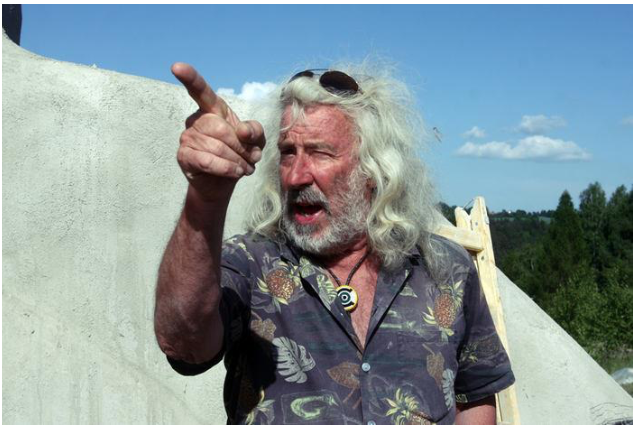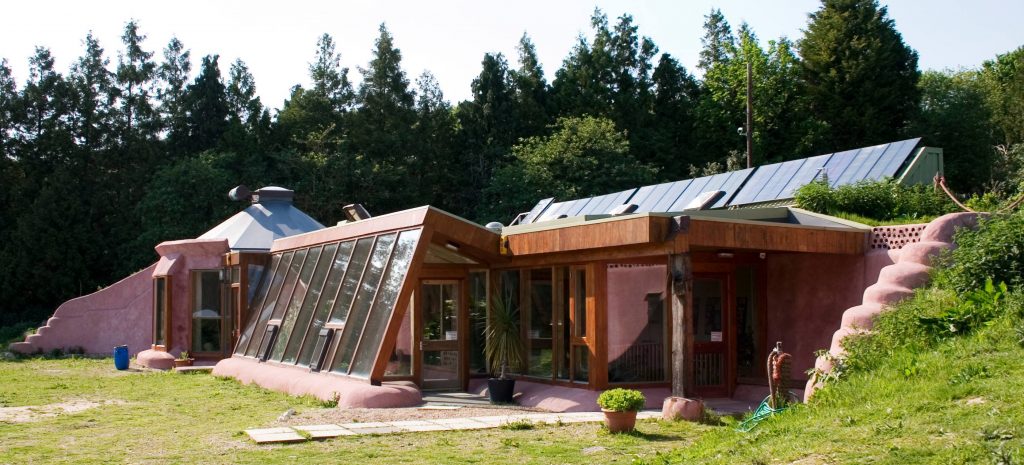Michael Reynolds is an American architect internationally recognized as a pioneer of self-sustainable building designs. He developed a new way of building that perfectly meets human needs and preserves the environment, avoiding an extensive use of natural exhaustible resources. These buildings are called Earthships and are intended to be “off-the-grid” homes, with minimal reliance on public utilities and fossil fuels.

With his global organization Earthship Biotecture, Michael Reynolds has been building self-sustainable houses all over the world for the last 45 years. Earthships can be built in any part of the world, in any climate and still provide electricity, water, contained sewage treatment and sustainable food production. Earthship construction drawings are also designed to meet standard building code requirements (LEED certification) so you can get a permit no matter where you are.
First of all, only natural or repurposed materials are used to build the entire structure. The main resources, considered the huge availability all over the world, are tires. Packed tightly with rammed-earth, considering their weight (around 300 pounds) and width, they result as perfect self-supporting bricks for the load- bearing walls and the structure does not even require foundation to be stable. Tires are interspersed with recycled aluminum cans and plastic bottles and then the walls are plastered with mud. The interior is generally furnished with reclaimed wood and metals.
The rammed-earth tires are also perfect thermal mass bricks: the sun rays enter during the day through the plenty of windows on the South side and the skylights on the roof, the floor and walls store the heat and release it during the night. In the summer the temperature inside remains in balance with the temperature of the earth and there are also mechanisms, such as buried cooling tubes or operable vent boxes, that allow a natural ventilation for cooling.
Thermal and solar heating and cooling systems and super-efficient appliance make it possible a minimal reliance on fossil fuel and wood. The energy requirement (almost 25% with respect to a conventional home) can be almost entirely satisfied using solar panels and small windmills. In addition, Reynolds states that the total utility bill of his house is $100 per year to run the propane for the cook stove (almost negligible comparing to a conventional home utility bill).
As regards water, it is collected from the rain and snowmelt on the roof. After being stored into cisterns, filtered and heated up with a solar system, it can be used for bathing, washing dishes and the laundry. Grey water is stored into interior botanic cells, plants use it and clean it and then it can be used for flushing toilets. Finally, the water is used for wetting exterior landscaping plants. The use and reuse of rain water results in food production and landscaping without contaminating underground water aquifers. In fact, within an Earthship a consistent amount of organic food is produced all the year round using some characteristic fruit and vegetables growing systems, such as mini hydroponic planter in suspended buckets or particular aqua botanical systems.

Earthships cost about the same as a conventional home: as we can see on the Earthship Biotecture web site, the price is around $230 per square foot and for the construction drawings it ranges from $5,000 to $10,000 depending on size. However you can save a lot of money both by building your own house without the help of the organization (that would cut the cost by close to 40%) and also considering the reduction of the utility bill.
Many Earthships have been built in different cities of Africa and, most recently, also in Central and South America. In 2000, the first one in Europe was built in Belgium and then also other ones in the UK. The main problem, in addition to the hostility of the institutions, was the adaptation of the principles developed in the USA to the European climate and general context. Nowadays, after several research and adjustments, Earthships have been built or are being built in Portugal, Spain, France, Belgium, The Netherlands, United Kingdom, Sweden, Denmark, Germany, Estonia and Czech Republic. An Earthship was also built in earthquake-ravaged Haiti, providing an efficient way of recycling the rubble there with an amazing and enthusiastic collaboration of the local people as volunteers.
In conclusion, Earthship is an attractive idea, beneficial for the planet and for the people, that makes it possible to adapt out life style to the needs of the environment without giving up our comfort. Many things still have to be fixed in order to make it perfectly suitable all over the world but the challenge is open. If you are interested in learning more about Green Buildings and Earthships, there is the official web site where you can find many news about the activity of the organization and also about internships, humanitarian build opportunities, global workshops and the Earthship Academy Program:



